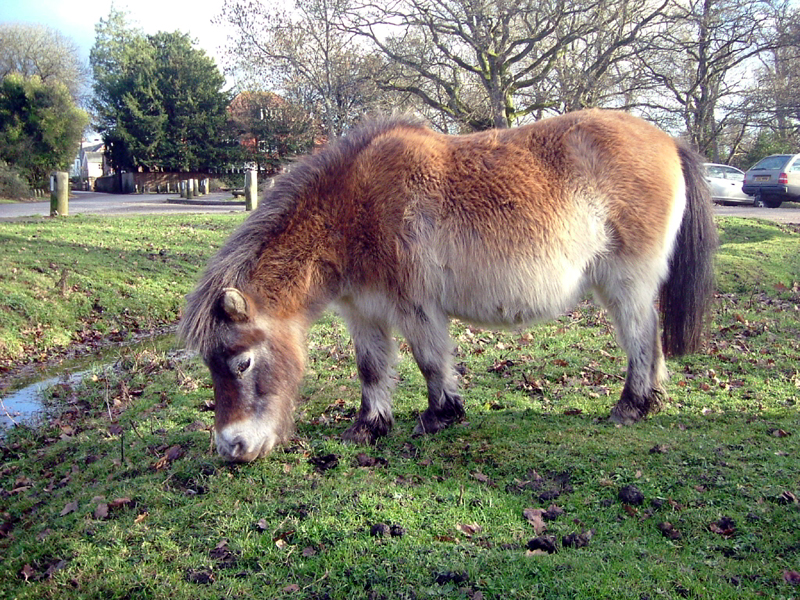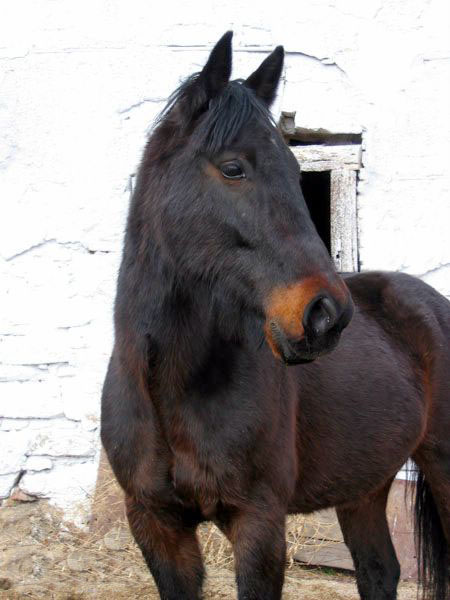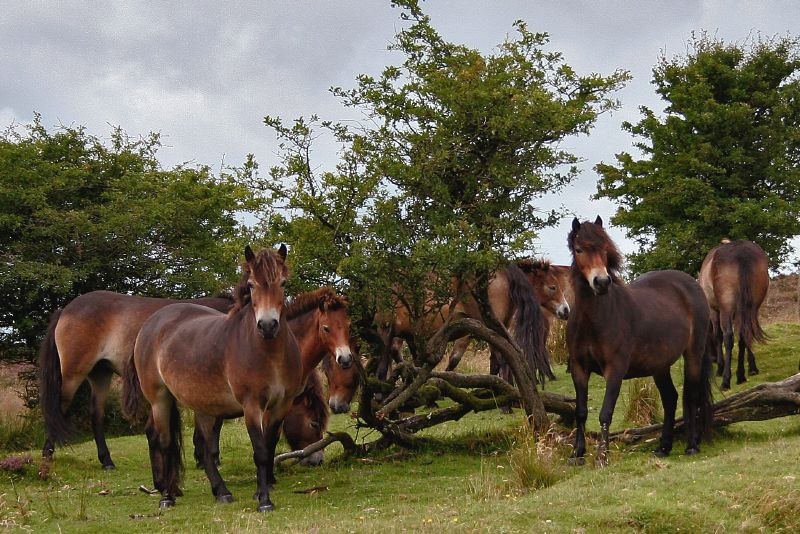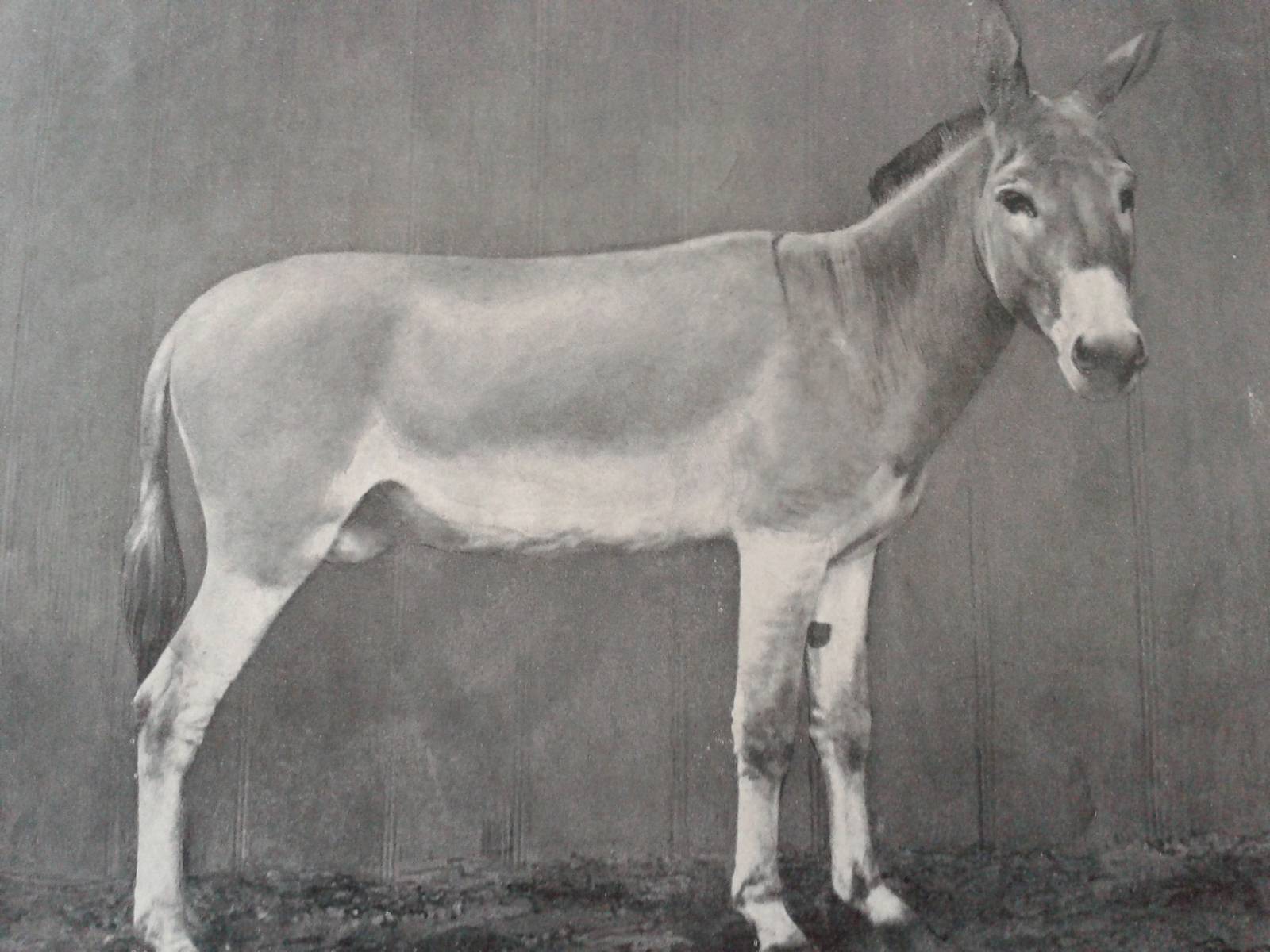|
Pangaré
Pangaré is a coat Phenotypic_trait, trait found in some horses that features pale hair around the eyes, muzzle, and underside of the body. These pale areas can extend up to the flanks, throat and chest, behind the elbows, in front of the Stifle joint, stifle, and up the buttock. Animals with the pangaré trait are sometimes called "mealy" or "light-pointed". The color of these lighter areas depends on the underlying color and ranges from off-white to light tan. This type of coloration is most often found in breeds such as the Fjord horse, Exmoor Pony, and Haflinger (horse), Haflinger. Wild Equus (genus), equids like the Przewalski's horse, onager, African wild ass, kiang as well as the domestic donkey exhibit pangaré as a rule. Pangaré is thought to be a type of protective countershading. Horse foals are often born with "foal pangaré" or light points, especially over black haired areas, which they lose when they shed their foal coats. At one time, the Seal brown (horse), se ... [...More Info...] [...Related Items...] OR: [Wikipedia] [Google] [Baidu] |
Points (coat Color)
Points are specific areas of an animal coat that are colored differently from the main body colorations. Point coloration may be represented by a pale body color and relatively darker extremities, such as face, ears, feet, tail, and external sex organs, as seen on Siamese cats. However, colored points can be found in many mammal species and some points are lighter than the main body color. Temperature-dependent colorpoint In many species, colorpoint patterns come from a genetic mechanism causing pigment to be produced only in cooler areas of the body, called acromelanism. This can be seen in cats, dogs (rare), fancy rats, guinea pigs, and rabbits. File:Ghislaine 6028.jpg, Cat File:Rat siamese.JPG, Fancy rat File:Himalayan-Guinea pig.jpg, Guinea pig File:Króliki kalifornijskie 666.jpg, Rabbit Dogs Colored points in dogs are lighter than the body coat, and usually tan. Tan points include small patches above the eyes and on the cheeks, the sides of the muzzle, front of n ... [...More Info...] [...Related Items...] OR: [Wikipedia] [Google] [Baidu] |
Seal Brown (horse)
Seal brown is a equine coat color, hair coat color of horses characterized by a near-black body color; with black point coloration, points, the mane, tail and legs; but also reddish or tan areas around the eyes, muzzle, behind the elbow and in front of the Stifle joint, stifle. The term is not to be confused with "brown", which is used by some breed registry, breed registries to refer to either a seal brown horse or to a bay (horse), dark bay without the additional characteristics of seal brown. Like bay (horse), bay, the seal brown color lacks the Agouti signalling peptide, non-agouti mutation that would create a fully black horse. The genetics behind seal brown are not known, but some think it is caused by an allele of agouti called ''At''. A genetic testing, DNA test said to detect the seal brown (At) allele was developed, but the test was never subjected to peer review and due to unreliable results was subsequently pulled from the market. The similar Bay (horse), dark bay coa ... [...More Info...] [...Related Items...] OR: [Wikipedia] [Google] [Baidu] |
Exmoor Pony
The Exmoor Pony is a British breed of pony or small horse. It is one of the mountain and moorland pony breeds native to the British Isles, and so falls within the larger Celtic group of European ponies. It originates on, and is named for, the Exmoor area of moorland in north-eastern Devon and western Somerset, in south-west England, and is well adapted to the climate conditions and poor grazing of the moor. Some still live there in a near-feral state, but most are in private ownership. Written records of ponies on Exmoor start with the Domesday Book in 1086. After centuries of being a "Royal Forest" (not an area of trees but a hunting ground), most of Exmoor was sold in 1818. Thirty ponies, identified as the original old type, were moved to neighbouring moorland; these were the foundation stock of the present-day breed. A breed society, the Exmoor Pony Society, was formed in 1921; the first stud-book was published in 1963. The ponies came close to extinction during the Seco ... [...More Info...] [...Related Items...] OR: [Wikipedia] [Google] [Baidu] |
Onager
The onager (, ) (''Equus hemionus''), also known as hemione or Asiatic wild ass, is a species of the family Equidae native to Asia. A member of the subgenus ''Asinus'', the onager was Scientific description, described and given its binomial name by German zoologist Peter Simon Pallas in 1775. Six subspecies are accepted. The onager is reddish-brown or yellowish-brown and has a broad dorsal stripe on the middle of the back. It weighs about and reaches about head-body length. It is among the Fastest animals#Mammals, fastest mammals, capable of running . The onager had a wider range from southwest and central to northern Asia including the Levant region, Arabian Peninsula, Afghanistan and Siberia; the prehistoric European wild ass subspecies ranged through Europe until the Bronze Age. During the early 20th century, it lost most of its range in the Middle East and Eastern Asia and lives today in Iran, Kazakhstan, Uzbekistan, Turkmenistan, India, Mongolia and China. It inhabits de ... [...More Info...] [...Related Items...] OR: [Wikipedia] [Google] [Baidu] |
Bay (horse)
Bay is a equine coat color, hair coat color of horses, characterized by a reddish-brown or brown body color with a black point coloration on the mane (horse), mane, tail (horse), tail, Pinna (anatomy), ear edges, and lower legs. Bay is one of the most common coat colors in many horse breeds. The black areas of a bay horse's hair coat are called "black points", and without them, a horse is not a bay horse. Black points may sometimes be covered by white horse markings, markings; however such markings do not alter a horse's classification as "bay". Bay horses have dark skin – except under white markings, where the skin is pink. Genetically, bay occurs when a horse carries both at least one dominant Agouti gene and at least one dominant Extension gene. While the basic genetics that create bay coloring are fairly simple, the genes themselves and the mechanisms that cause shade variations within the bay family are quite complex and, at times, disputed. The genetics of dark shades ... [...More Info...] [...Related Items...] OR: [Wikipedia] [Google] [Baidu] |
Black (horse)
Black is a hair coat color of horses in which the entire hair coat is black. It is not uncommon to mistake dark chestnuts or bays for black. Black horses have dark brown eyes, black skin, and wholly black hair coats without any areas of permanently reddish or brownish hair. They may have pink skin beneath any white markings under the areas of white hair, and if such white markings include one or both eyes, the eyes may be blue. Many black horses "sun bleach" with exposure to the elements and sweat, and therefore their coats may lose some of their rich black character and may even resemble bay or seal brown, though examination of the color of hair around the eyes, muzzle and genitals will determine color. Some breeds of horses, such as the Friesian horse, Murgese and Ariegeois (or Merens), are almost exclusively black. Black is also common in the Fell pony, Dales pony, Ostfriesen and Alt-Oldenburger, Kladruber, and Groningen. Visual identification When identifying ... [...More Info...] [...Related Items...] OR: [Wikipedia] [Google] [Baidu] |
Foal
A foal is an equine up to one year old; this term is used mainly for horses, but can be used for donkeys. More specific terms are colt (horse), colt for a male foal and filly for a female foal, and are used until the horse is three or four. When the foal is nursing from its dam (mother), it may also be called a "suckling". After it has been weaned from its dam, it may be called a "weanling". When a mare is pregnant, she is said to be "in foal". When the mare gives birth, she is "foaling", and the impending birth is usually stated as "to foal". A newborn horse is "foaled". After a horse is one year old, it is no longer a foal, and is a "yearling (horse), yearling". There are no special age-related terms for young horses older than yearlings. When young horses reach breeding maturity, the terms change: a filly over three (four in horse racing) is called a mare, and a colt over three is called a stallion. A castrated male horse is called a gelding regardless of age; however, collo ... [...More Info...] [...Related Items...] OR: [Wikipedia] [Google] [Baidu] |
Countershading
Countershading, or Thayer's law, is a method of camouflage in which animal coloration, an animal's coloration is darker on the top or upper side and lighter on the underside of the body. This pattern is found in many species of mammals, reptiles, birds, fish, and insects, both in predators and in prey. When light falls from above on a uniformly coloured three-dimensional object such as a sphere, it makes the upper side appear lighter and the underside darker, grading from one to the other. This pattern of light and shade makes the object appear solid, and therefore easier to detect. The classical form of countershading, discovered in 1909 by the artist Abbott Handerson Thayer, works by counterbalancing the effects of self-shadowing, again typically with grading from dark to light. In theory this could be useful for military camouflage, but in practice it has rarely been applied, despite the best efforts of Thayer and, later, in the Second World War, of the zoologist Hugh Cott. ... [...More Info...] [...Related Items...] OR: [Wikipedia] [Google] [Baidu] |
Donkey
The donkey or ass is a domesticated equine. It derives from the African wild ass, ''Equus africanus'', and may be classified either as a subspecies thereof, ''Equus africanus asinus'', or as a separate species, ''Equus asinus''. It was domesticated in Africa some years ago, and has been used mainly as a working animal since that time. There are more than 40 million donkeys in the world, mostly in underdeveloped countries, where they are used principally as Working animal, draught or pack animal, pack animals. While working donkeys are often associated with those living at or below subsistence, small numbers of donkeys or asses are kept for breeding, as pets, and for livestock protection in developed countries. An adult male donkey is a ''jack'' or ''jackass'', an adult female is a ''jenny'' or ''jennet'', and an immature donkey of either sex is a ''foal''. Jacks are often mated with horse, female horses (mares) to produce ''mule, mules''; the less common hybrid of a stalli ... [...More Info...] [...Related Items...] OR: [Wikipedia] [Google] [Baidu] |
Kiang
The kiang (''Equus kiang'') is the largest of the ''Asinus'' subgenus. It is native to the Tibetan Plateau in Ladakh India, northern Pakistan, Tajikistan, China and northern Nepal. It inhabits montane grasslands and shrublands. Other common names for this species include Tibetan wild ass, khyang and gorkhar. Characteristics The kiang is the largest of the wild asses, with an average height at the withers of . They range from high at the withers, with a body long, and a tail of . Kiangs have only slight sexual dimorphism, with the males weighing from , while females weigh . They have a large head, with a blunt muzzle and a convex nose. The mane is upright and relatively short. The coat is a rich chestnut colour, darker brown in winter and a sleek reddish brown in late summer, when the animal moults its woolly fur. The summer coat is long and the winter coat is double that length. The legs, underparts, end of the muzzle, and the inside of the ears are all white. A broad, dar ... [...More Info...] [...Related Items...] OR: [Wikipedia] [Google] [Baidu] |
African Wild Ass
The African wild ass (''Equus africanus'') or African wild donkey is a wild member of the horse family, Equidae. This species is thought to be the ancestor of the domestic donkey (''Equus asinus''), which is sometimes placed within the same species. They live in the deserts and other arid areas of the Horn of Africa, in Eritrea, Ethiopia Ethiopia, officially the Federal Democratic Republic of Ethiopia, is a landlocked country located in the Horn of Africa region of East Africa. It shares borders with Eritrea to the north, Djibouti to the northeast, Somalia to the east, Ken ... and Somalia. It formerly had a wider range north and west into Sudan, Egypt, and Libya. It is Critically Endangered, with about 570 existing in the wild. Description The African wild ass is about tall and weighs approximately . The short, smooth coat is a light grey to fawn colour, fading quickly to white on the undersides and legs. There is a slender, dark dorsal stripe in all subspecie ... [...More Info...] [...Related Items...] OR: [Wikipedia] [Google] [Baidu] |
050103 2283 Hants Pony
5 (five) is a number, numeral and digit. It is the natural number, and cardinal number, following 4 and preceding 6, and is a prime number. Humans, and many other animals, have 5 digits on their limbs. Mathematics 5 is a Fermat prime, a Mersenne prime exponent, as well as a Fibonacci number. 5 is the first congruent number, as well as the length of the hypotenuse of the smallest integer-sided right triangle, making part of the smallest Pythagorean triple ( 3, 4, 5). 5 is the first safe prime and the first good prime. 11 forms the first pair of sexy primes with 5. 5 is the second Fermat prime, of a total of five known Fermat primes. 5 is also the first of three known Wilson primes (5, 13, 563). Geometry A shape with five sides is called a pentagon. The pentagon is the first regular polygon that does not tile the plane with copies of itself. It is the largest face any of the five regular three-dimensional regular Platonic solid can have. A conic is determined ... [...More Info...] [...Related Items...] OR: [Wikipedia] [Google] [Baidu] |








